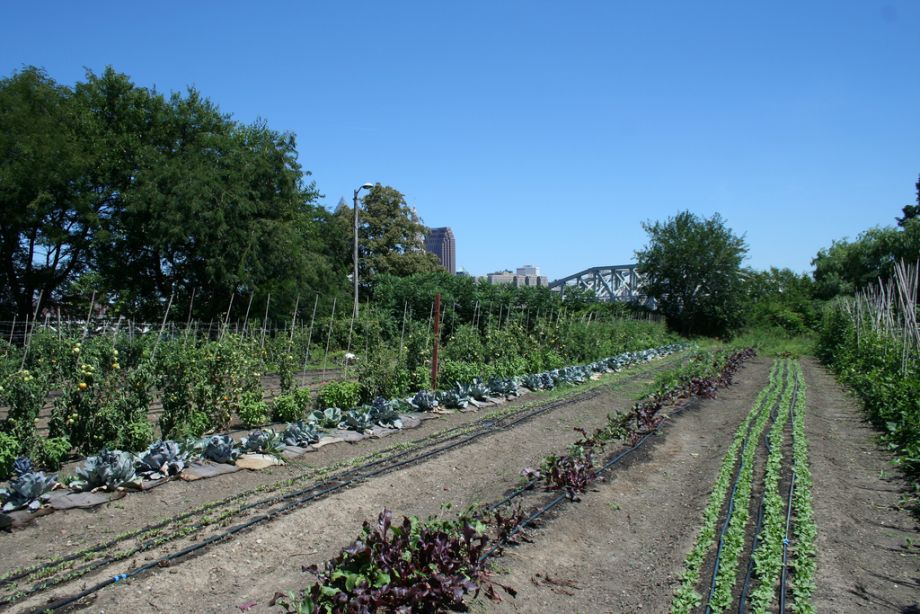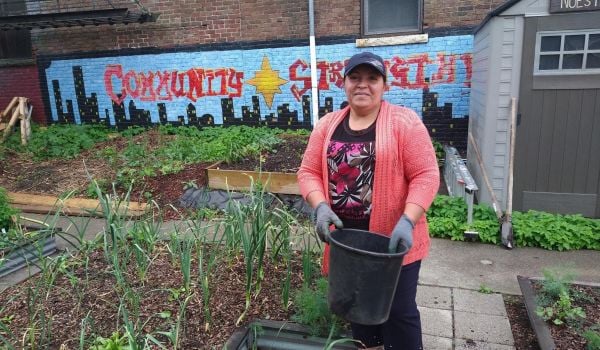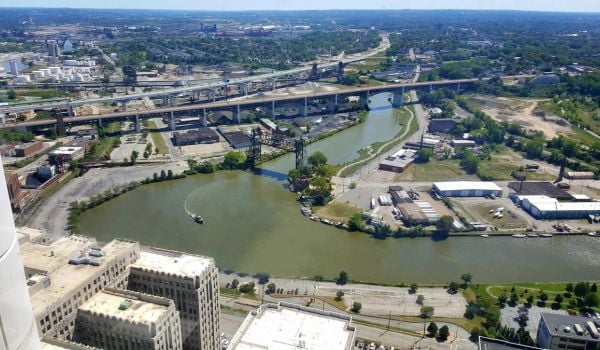Urban agriculture has become the flagship initiative [and crutch] of many of America’s struggling post-industrial cities. The number of community gardens and urban farms that have popped up in just the last four years is staggering. It has gone so far as to become a clichéd trope of beautification and community uplift schemes alike. And, indeed, the sheer volume of urban ag initiatives can make it hard to tell the comprehensive and integrated from the piecemeal and half-baked. At first glance they all look much the same — a few brightly colored tomatoes and some robust kale poking up between sagging woodframes, hollowed-out factories and upright rowhouses. We have become familiar with the typology. But, some models go deeper — and wider — than others. Cleveland’s Ohio City Farm and its constellation of collaborators and investors, workers and consumers is one such model, one whose depth and breadth distinguishes it from its many urban ag peers.
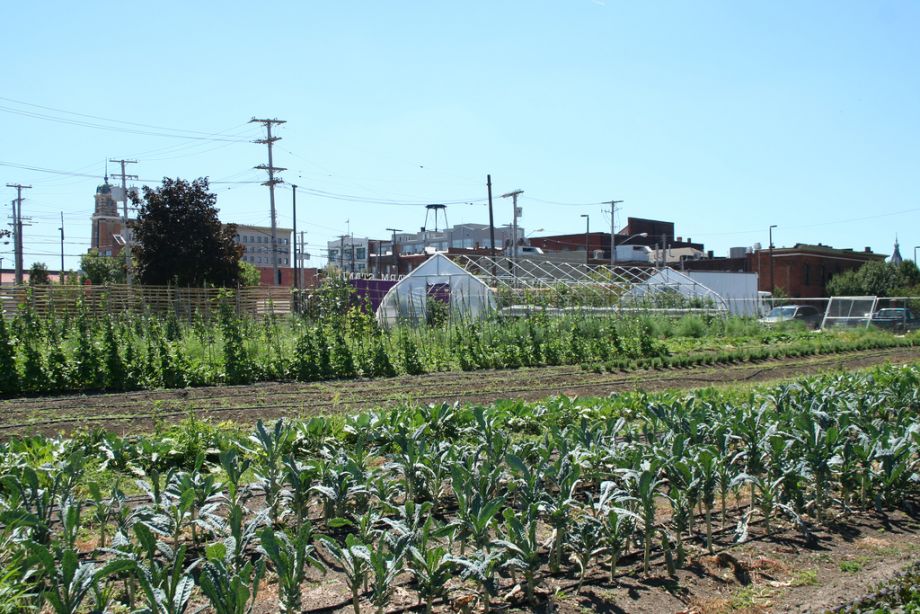
A view of the Ohio City Farm. Credit: MMW Horticulture Group.
The Ohio City neighborhood is in the midst of a renaissance. One of Cleveland’s oldest neighborhoods and home to the 101-year-old West Side Public Market, the area has long attracted a diverse mix of families and artists. Now it is also home to farms and food producers.
In 2010, the first seeds were planted in Ohio City, thanks to the an sweeping campaign spearheaded by Ohio City Inc and managed through an initiative called Ohio City Fresh Food Collaborative.
Formed with the intention to solidify Ohio City as a regional food hub, the collaborative has helped develop a cluster of urban farm plots and create the support infrastructure to get local producers selling at the historic West Side Market. Perhaps more critically, it has created jobs and trained some of the city’s most vulnerable populations to do them.
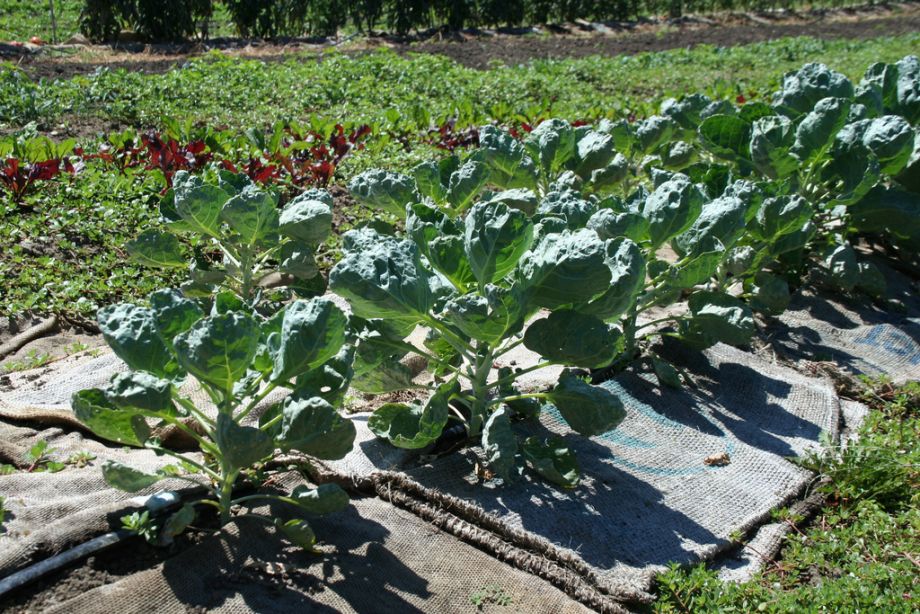
Some Ohio City Farm produce, growing strong only 1 mile from downtown Cleveland. Credit: MMW Horticulture Group.
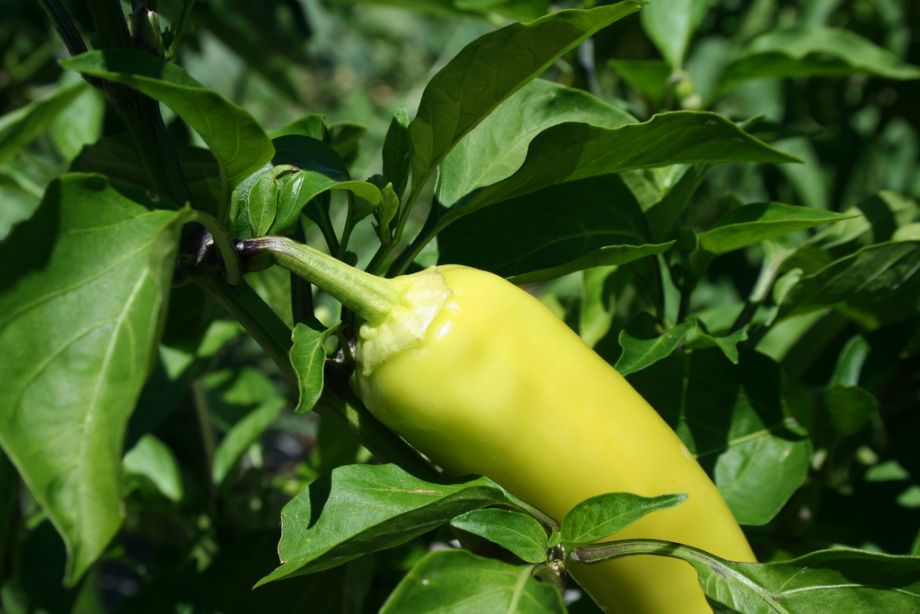
Some Ohio City Farm produce, growing strong only 1 mile from downtown Cleveland. Credit: MMW Horticulture Group.
The eponymous Ohio City Farm, with six acres of tended land, holds the title for largest contiguous urban farm plot, but its true distinction comes from its program to employ people with disabilities, Cleveland Crops and a program for recent refugees,Refugee Employment Agricultural Program (REAP), developed by The Refugee Response advocacy and support group.
These partnerships fill important niches. Cleveland Crops, concerned at the decline in manufacturing jobs — a once reliable source of employment for those with developmental disabilities — latched onto agriculture as an important substitute industry for the city’s developmentally disabled. Refuge Response came to farming after doing a 2009 study that revealed that almost 85 percent of the refugee population in Cleveland, across nationality (Burmese, Bhutanese, Somalian, Ukrainian, Russian and Iraqi, among others), were primarily qualified as agricultural workers, because of experiences in their home countries.
Armed with that knowledge, Refugee Response approached Ohio City Inc. to explore options for developing a profit-generating farm. The revenue generated from the REAP’s plot of land on the Ohio City Farm now represents about 40% of Refugee Response’s operating budget, all of which is generated through contracts with local restaurants and the contributions of 50+ CSA members.
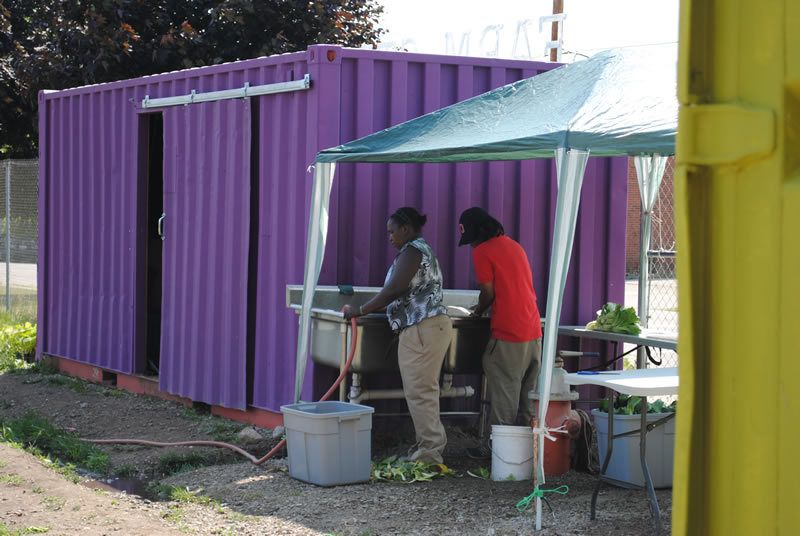
Some of the farm’s workers, standing by the farm stand. Credit: LAND studio.
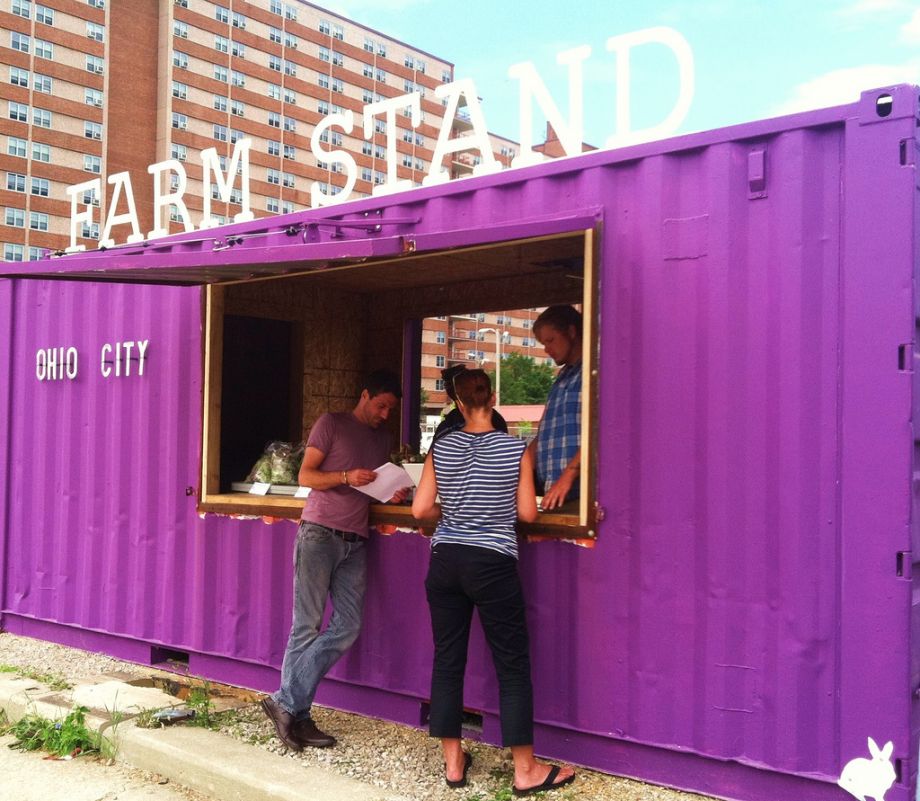
The Ohio City Farm Stand, in action on a market day. Credit: LAND studio.
These non-profit job generator go above and beyond the rhetoric of most community gardening efforts. And while Ohio City Farm certainly isn’t the silver bullet that will solve all of Cleveland’s problems, as the physical roots of the farm’s vegetation wind around one another beneath the soil, stabilizing land that was beginning to slip into the Cuyahoga River valley nearby, the social roots of the many organizations invested in the farm are beginning to connect across ethnic, class and cultural divides, straining to close the gaps in a rapidly gentrifying neighborhood. The CSA programs operating out of the Ohio City Farm serve as a community anchor bringing some of the neighborhood’s wealthy foodies into contact with the Market District’s poorest, most marginalized residents and stretching the pedestrian traffic associated with the public market towards Detroit/Superior Bridge and the social housing along that stretch of 25th.
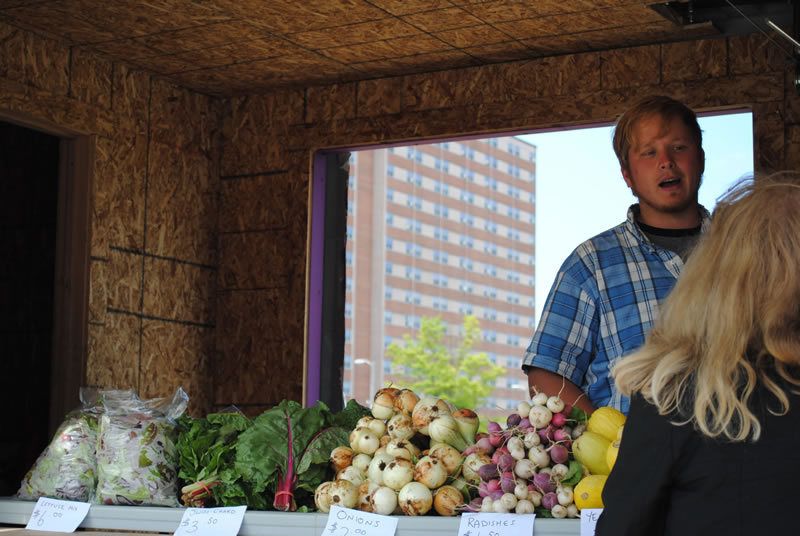
The Ohio City Farm Stand, in action on a market day. Credit: LAND studio.
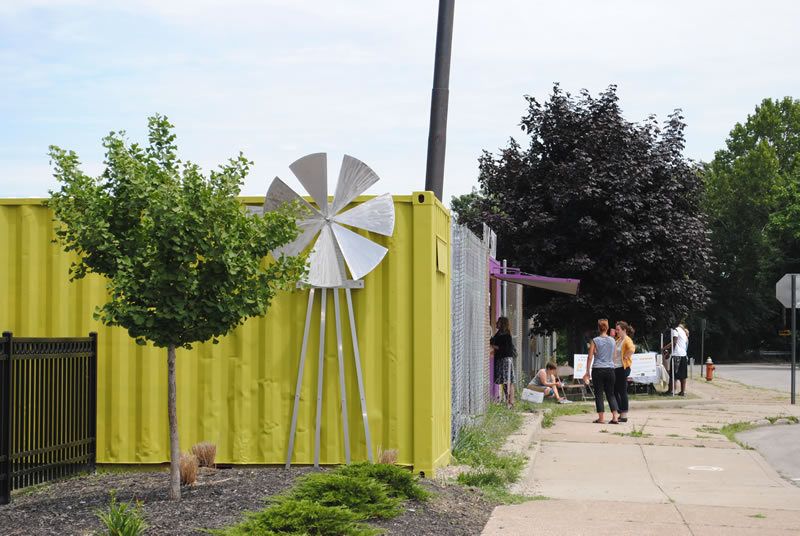
Some visitors lingering around the farm stand on a market day. Credit: LAND studio.
Indeed, the complex and multi-dimensional approach of the Ohio City Fresh Food Collaborative offers a compelling model for post-industrial cities across the country. As one supporter, Tim Smith of the Cleveland Community Greenhouse Partners explained, urban agriculture initiatives like this one are part of a broad re-envisioning of the Rust Belt city. As Smith put it in a 2010 Cleveland Scene article, “there’s this hope that manufacturing will somehow rise again as an engine of economic support, that all of the jobs will come back and all of the people will come back. As much as light industry and manufacturing did to build this town, we can’t rely on it anymore.” Instead, he urges, we must begin to build “something that can support itself in a way that’s clean and doesn’t burn up resources.”
Smith’s comments point back to Cleveland’s precedent-setting urban ag zoning reform, spearheaded by Councilman Joe Cimperman and pushed through in 2010 as plans for the Ohio City Farm were coalescing. These new urban ag policies rezoned large swaths of underused residential neighborhoods for large-scale urban food production. Farms like Rid-All Green Partnership in a desolate section of the Kinsman neighborhood long known as the “Forgotten Triangle” represent the beginning of a more systematic reform of zoning and redefinition of what constitutes the “best use” of underpopulated urban land. This reform and redefinition could begin to support alternatives to the monopoly, instability and dependency that plagued the midwest’s historic industrial economy.
Urban ag will not, cannot be the replacement of the Rust Belt’s industrial economy. But, it can be a piece of a more diverse and resilient constellation of industries that are picking up the slack left by the half-century long collapse of US industry.

